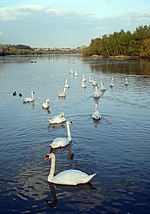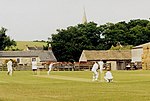Osgoldcross Wapentake
Use British English from September 2017Wapentakes of the West Riding of YorkshireWest Yorkshire geography stubs

Osgoldcross was a wapentake of the West Riding of Yorkshire, England. It included the parishes of Adlingfleet, Badsworth, Burghwallis, Campsall, Castleford, Darrington, Kellington, South Kirkby, Owston, Pontefract, Whitgift, Womersley, Ferry Fryston and parts of Featherstone, Snaith and Wragby. The original meeting place of the wapentake was the area which later became Pontefract Market Place.
Excerpt from the Wikipedia article Osgoldcross Wapentake (License: CC BY-SA 3.0, Authors, Images).Osgoldcross Wapentake
Newton Lane,
Geographical coordinates (GPS) Address Nearby Places Show on map
Geographical coordinates (GPS)
| Latitude | Longitude |
|---|---|
| N 53.744 ° | E -1.31 ° |
Address
Newton Lane
Newton Lane
WF11 9JH , Ledsham
England, United Kingdom
Open on Google Maps








